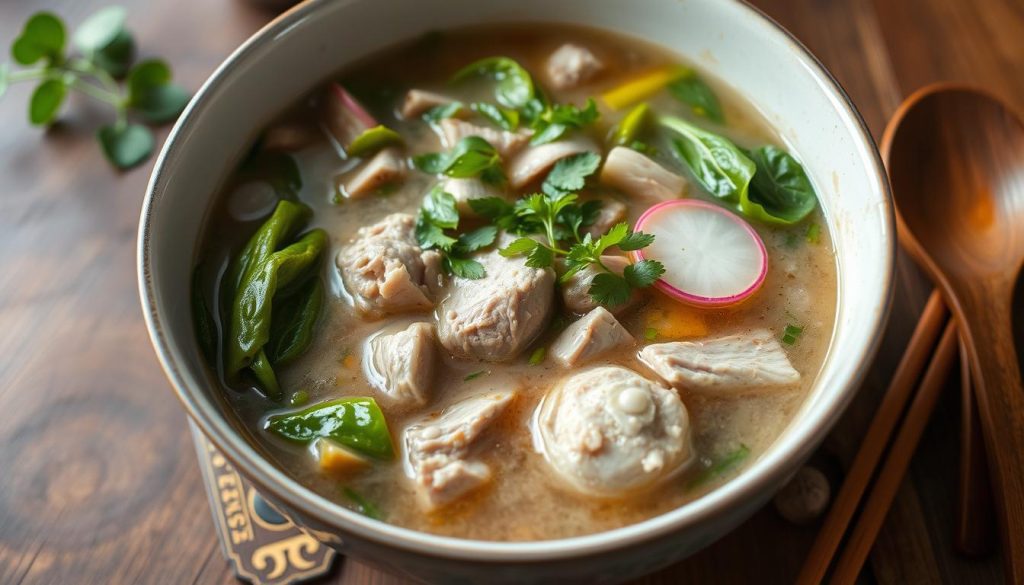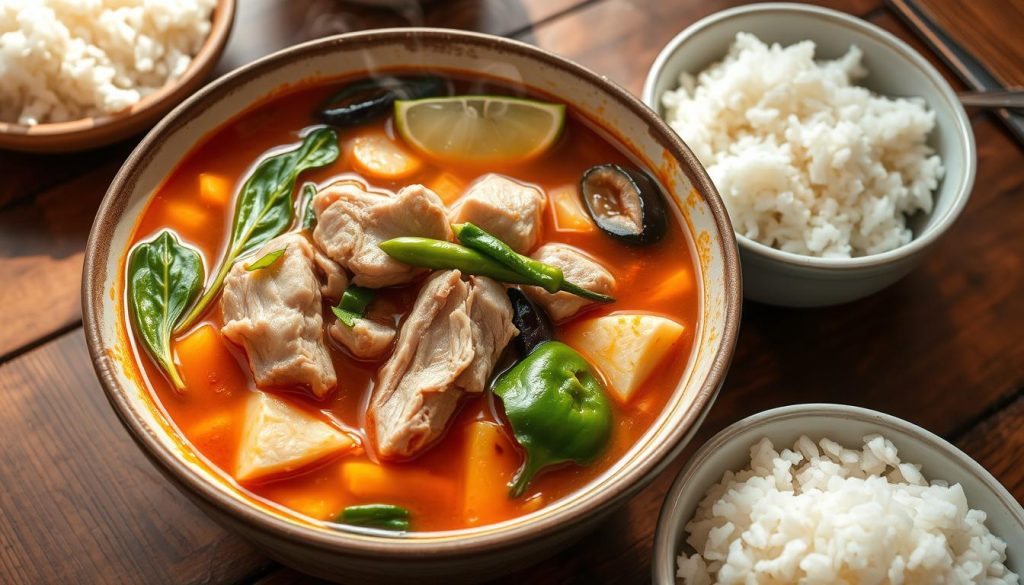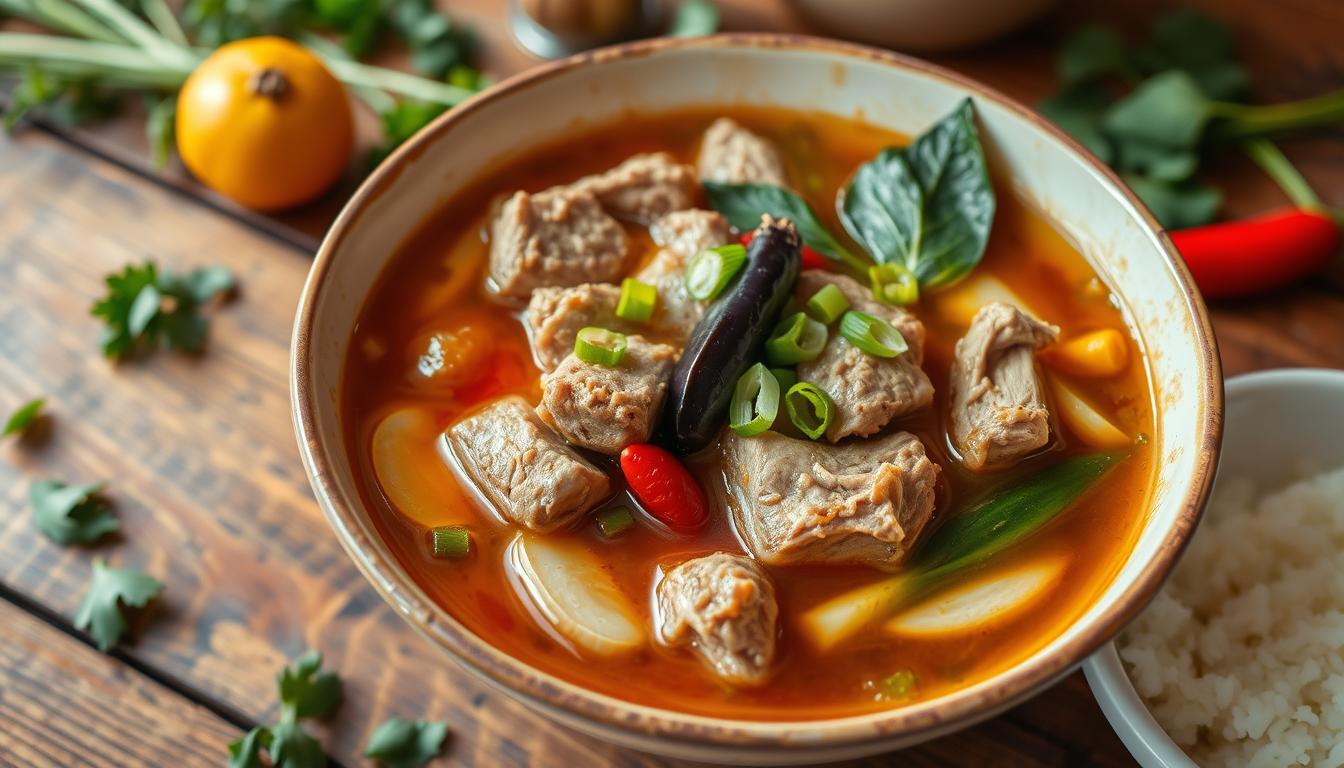In a Filipino home, the smell of a delicious sinigang recipe brings back memories of comfort. This tangy soup, made with tamarind, meat, and fresh vegetables, is a staple of Filipino cuisine. Crafting the perfect sinigang recipe ensures every bowl is filled with authentic flavors. As a kid, it warmed me on rainy days. Now, it’s a treasured part of my cooking and one of my go-to dishes for special occasions.
Sinigang is a key Filipino dish, showing off the country’s bold tastes and rich culture. It’s a hearty soup with a sour broth, flavored with tamarind. It’s more than just food; it’s a family gathering point, a soul-warming dish, and a symbol of the Philippines’ varied cuisines.
A vibrant bowl of sinigang soup, filled with tender pork, fresh vegetables like radish and eggplant, and a splash of tamarind broth, garnished with green onions and chili peppers, set on a rustic wooden table with fresh herbs and rice on the side, warm lighting highlighting the rich colors and textures.
Main Highlights
- Sinigang is a beloved Filipino sour soup made with meat or seafood, vegetables, and a sour broth flavored with tamarind.
- It is a popular comfort food in the Philippines, often enjoyed on rainy days or as a warming meal.
- Sinigang is considered a culinary representation of the Philippines’ diverse regional cuisines.
- The sour broth is the signature element of sinigang, providing a harmonious balance of flavors.
- Sinigang is a versatile dish that can be made with a variety of proteins and vegetables.
Understanding the Sinigang Recipe: A Guide to This Filipino Sour Soup
Sinigang is a key part of Filipino food, known for its sour taste. A well-prepared sinigang recipe showcases the perfect balance of tanginess and savoriness. From family gatherings to rainy day meals, this dish remains an enduring symbol of Filipino culinary heritage.
Origins and Cultural Significance of the Sinigang Recipe
Sinigang is a favorite in the Philippines, with a history before colonial times. It has indigenous roots and has been a family favorite for many years. It shows the country’s rich food culture.
What Makes the Sinigang Recipe Special
The sour broth of sinigang is made with tamarind. It cooks proteins like pork, beef, and chicken. It also uses seafood and a variety of vegetables.
Regional Variations of the Sinigang Recipe
Sinigang is loved all over the Philippines, but it has different versions. Similar sour soups are found in Malaysia, Indonesia, Vietnam, and Thailand. In the Philippines, there are many sinigang types, like Sinigang na Baboy and Sinigang na Isda.

A steaming bowl of sinigang, filled with tender pork, vibrant green vegetables like spinach and radish, and a rich, cloudy broth, garnished with fresh herbs, set against a rustic wooden table background, with traditional Filipino utensils on the side.
Sinigang is great for any meal or special event. The choice of protein and souring agent depends on personal taste and what’s in season. While adobo and lechon are famous, sinigang is also a beloved dish in the Philippines.
Key Ingredients for Crafting the Perfect Sinigang Recipe
Sinigang is a favorite Filipino sour soup, and an authentic sinigang recipe is known for its complex flavors.
The main protein is often pork belly or ribs, especially in sinigang na baboy. But, you can also use fish like pompano, chicken, shrimp, or salmon for different tastes.
The sourness comes from tamarind, the best choice. Guava and lemon can also be used, but tamarind is the top pick. For a vegan version, skip animal proteins and use vegan fish sauce flavored with mushrooms or soy sauce. Vegetables like okra, daikon radish, onion, tomato, and leafy greens add to the flavor.
They also bring important nutrients and health benefits. To make sinigang, sauté aromatics, create the soup base, add veggies, and simmer. Then, add the protein and greens before serving.
This method makes the dish healthy and tasty, without too much fat or calories. Knowing the key ingredients helps home cooks make a real and tasty sinigang recipe.

A vibrant arrangement of traditional Sinigang ingredients, featuring fresh tamarind pods, juicy tomatoes, radish slices, green long beans, a bunch of leafy water spinach, succulent pork belly pieces, and aromatic herbs, all set against a rustic wooden countertop. The colors should be bright and fresh, showcasing the natural beauty of the ingredients.
“Sinigang is one of the most popular soups in the Philippines, known for its perfect balance of sour, savory, and umami flavors.”
Choosing the Perfect Meat for Your Sinigang Recipe
Choosing the right meat is key to a great sinigang. Pork is a top pick, with belly, ribs, or shoulder being favorites. But, you can also use beef, chicken, shrimp, or fish for a different twist.
Pork Cuts and Alternatives
Pork with a bit of fat is best for sinigang. This fat makes the dish taste richer. Choose pieces like belly, ribs, or shoulder for the best flavor.
Looking for something else? Beef, chicken, shrimp, or fish can also work well. Beef gives a bold taste, while chicken and fish add a leaner option.
Preparing the Meat
How you prepare the meat matters a lot. For pork, blanching can remove unwanted fat. This makes the broth cleaner. Then, add the meat to the broth to mix the flavors.
| Protein | Recommended Cut | Preparation |
|---|---|---|
| Pork | Pork belly, ribs, or shoulder | Cut into bite-sized pieces, optionally blanch to remove impurities |
| Beef | Chuck or brisket | Cut into bite-sized pieces |
| Chicken | Thighs or drumsticks | Cut into bite-sized pieces |
| Shrimp | Peeled and deveined | Add towards the end of cooking to prevent overcooking |
| Fish | Tilapia or milkfish | Cut into chunks, add towards the end of cooking |

A vibrant bowl of pork sinigang, featuring tender chunks of pork, fresh vegetables like radishes, water spinach, and eggplant, all immersed in a rich, tangy broth. The soup is garnished with green chili peppers and a wedge of lime, served alongside a bowl of steamed rice, with steam rising gently from the hot dish. The setting is a rustic wooden table with natural lighting highlighting the vibrant colors of the ingredients.
“Sinigang is a beloved Filipino dish that showcases the perfect balance of sour, savory, and umami flavors. The choice of meat is crucial in creating a truly authentic and satisfying sinigang experience.”
The Art of Souring Agents in Your Sinigang Recipe
Sinigang, the beloved Filipino sour soup, is known for its complex flavors. The art of choosing the right souring agents is key. Tamarind, the most common, comes in fresh, paste, or concentrate forms.
But there’s more to Sinigang than just tamarind. Fruits like guava, bilimbi, green mango, and pineapple add their own tartness. The choice of agent depends on where you are and what’s available, showing off the Philippines’ diverse flavors.
Choosing the right souring agent is crucial for a perfect Sinigang. Whether it’s tamarind’s tanginess or green mango’s freshness, each adds a unique taste. This is what makes Sinigang special.
Start your Sinigang adventure by trying different souring agents. Find the one that you like best. The goal is to balance the sourness with the other flavors, creating a memorable meal.
Preparing Fresh Vegetables for Your Sinigang Recipe
Sinigang, the beloved Filipino sour soup, is known for its mix of flavors. Fresh vegetables are key to its taste. In the traditional recipe, a mix of Filipino vegetables are picked and prepared to make it authentic.
Traditional Vegetable Combinations
The main veggies in sinigang are tomatoes, onions, daikon radish, eggplant, string beans, and leafy greens like spinach or bok choy. These sinigang vegetables are chosen to match the sour broth and the protein, like beef, pork, or seafood.
Proper Cutting Techniques
It’s important to prepare the veggies right to get the best taste and texture in sinigang. They are washed well and cut carefully. Cooking techniques like dicing, slicing, or quartering are used to make sure each piece cooks well and keeps its taste.
Cooking Order and Timing
The way veggies are added to the sinigang broth is a precise dance. The daikon radish, which takes longer to cook, goes in first. Then, quicker-cooking items like string beans and leafy greens are added. This order helps each veggie cook just right, keeping their flavors and textures in the sinigang dish.
| Vegetable | Preparation | Cooking Order |
|---|---|---|
| Daikon Radish | Peeled and sliced | First |
| Tomatoes | Diced | Second |
| Onions | Sliced | Second |
| Eggplant | Cubed | Third |
| String Beans | Cut into 2-inch pieces | Fourth |
| Spinach | Roughly chopped | Last |
Step-by-Step Sinigang Recipe
Learn how to make a tasty homemade sinigang, a favorite Filipino sour soup. This guide will show you how to make a real and tasty dish. It will make your taste buds happy.
- Start by heating 1 tablespoon of vegetable oil in a big pot or Dutch oven over medium-high heat.
- Add the pork belly or spareribs and brown them on all sides, about 5 to 7 minutes. Remove the meat from the pot and set it aside.
- In the same pot, add the remaining 1 tablespoon of vegetable oil and sauté the onions and tomatoes until softened, approximately 3 to 5 minutes.
- Return the browned meat to the pot and pour in 2 quarts of water. Bring the mixture to a boil, then reduce the heat to medium-low and let it simmer for 45 minutes to 1 hour, or until the meat is tender and easily pulls apart.
- Add the tamarind fruits or tamarind-flavored sinigang mix and fish sauce to the pot. Taste the broth and adjust the sourness and seasoning to your preference.
- Carefully add the string beans, finger chilis or banana peppers, eggplant, water spinach or bok choy, and radish. Simmer for an additional 5 to 10 minutes, or until the vegetables are tender but still crisp.
- Serve the homemade sinigang hot, accompanied by steamed rice. Enjoy the perfect balance of sour, savory, and slightly spicy flavors that make this classic Filipino dish so beloved.
By following these steps, you’ll make a delicious and authentic sinigang. It will take you to the vibrant flavors of the Philippines. Enjoy the rich, sour broth and the tender, succulent meat with fresh vegetables for a satisfying meal.
Tips for Achieving the Perfect Sour Broth in a Sinigang Recipe
Making the perfect sinigang broth is all about finding the right mix. You need a good balance of the tangy tamarind flavor and the savory parts. It’s all about choosing the right souring agents carefully.
Start with a little tamarind and add more until it’s just right. This way, you can adjust the sour taste to match the other flavors.
While cooking, make sure to remove any scum from the sinigang broth. This makes the soup look and feel better.
Being patient is key when making sinigang. Let the flavors mix for about 40-45 minutes. This long cooking time lets the tamarind flavor and other ingredients blend well.
Finally, add a bit of fish sauce or salt at the end. This last touch can make the balancing sour taste even better.
“The perfect sinigang broth is a harmonious dance between the tangy tamarind flavor and the savory elements of the dish. It’s a delicate balance that requires patience and precision to achieve.”
Serving Suggestions and Pairings for the Sinigang Recipe
Sinigang, the beloved Filipino sour soup, is traditionally served hot with white rice. This classic combo lets the tangy broth mix well with the rice’s neutral taste. A small dish of fish sauce with chili peppers is often on the side. It lets diners add more flavor to their sinigang.
Traditional Accompaniments
- Steamed white rice
- Fish sauce with chopped chili peppers
Modern Serving Ideas
Now, there are creative ways to enjoy sinigang. You can use it as a base for fusion dishes. Try it in rice bowls or with sides like quinoa or crusty bread for a twist.
| Sinigang Serving Idea | Description |
|---|---|
| Sinigang Rice Bowl | Serve sinigang over steamed rice, with extra veggies, proteins, and broth. |
| Sinigang Quinoa Salad | Mix sinigang broth with quinoa, veggies, and protein for a healthy meal. |
| Sinigang Bread Dippers | Offer crusty bread for dipping in the sour sinigang broth. |
These ideas let you try new flavors and textures while keeping the sinigang’s essence.

Sinigang
Equipment
- Large pot
- Ladle
- Knife
- Cutting board
Ingredients
- 2 lbs Pork ribs or pork belly, cut into chunks
- 8 cups Water
- 1 Medium onion notes: sliced
- 2 Large tomatoes notes: quartered
- 1 Packet Tamarind soup mix or 1/2 cup fresh tamarind pulp
- 1 tbsp Fish sauce notes: or to taste
- 1/2 tsp Salt notes: or to taste
- 1/4 tsp Black pepper
- 1 Cup Eggplant notes: sliced
- 1 Cup Long beans notes: cut into 2-inch pieces
- 1 Cup Radish notes: sliced
- 1 Cup Kangkong notes: water spinach, or substitute with baby spinach
- 1-2 Green chili peppers notes: optional, for spice
Instructions
- In a large pot, bring water to a boil and add pork ribs. Simmer for 5 minutes, then drain and rinse to remove impurities.
- Refill the pot with fresh water and bring to a boil. Add pork, onion, and tomatoes. Simmer for 30 minutes until the meat is tender.
- Stir in the tamarind soup mix (or fresh tamarind pulp), fish sauce, salt, and pepper. Simmer for another 5 minutes.
- Add eggplant, long beans, and radish. Cook for 5 minutes until vegetables are tender.
- Stir in kangkong and green chili peppers (if using). Let cook for another 2 minutes.
- Taste and adjust seasoning if needed. Serve hot with steamed white rice.
Notes
Conclusion
Sinigang is a beloved Filipino comfort food. It shows the country’s rich culinary heritage and love for sour flavors. This sour soup is loved worldwide, making it a global cultural cuisine.
By making sinigang at home, you can enjoy its delicious and healthy broth. You can also change the ingredients to fit your taste.
Sinigang is perfect for a warm meal on a cold day or a balanced meal any time. It can have different proteins like pork or seafood and many fresh vegetables. The secret to its sour taste comes from tamarind or other souring agents.
Exploring sinigang reveals its cultural importance in the Philippines. It’s celebrated on special days like baptisms and birthdays. Sinigang is easy to find in Filipino restaurants and to make at home with tamarind powders and pastes.
Try the flavors of this beloved Filipino comfort food. Let it take you on a journey through the Philippines’ vibrant culinary world.
FAQ
Sinigang is a Filipino soup known for its tangy, savory broth made with tamarind, meat, and fresh vegetables. It’s a comforting and flavorful dish enjoyed year-round.
Pork belly, ribs, or shoulder are the most common choices, but beef, shrimp, and fish work well too. Each protein gives a unique flavor to the dish.
If tamarind isn’t available, you can use green mango, calamansi, guava, or lemon juice as substitutes. Each adds a slightly different sourness to the broth.
Yes! Skip the meat and use mushrooms or tofu instead. For the broth, add miso paste or vegetable stock for extra depth of flavor.
Start with less tamarind and adjust to taste. You can also balance the flavors with fish sauce, salt, or a little sugar if needed.

This sinigang recipe looks so comforting and full of flavor, Olivia! Love how you break down the ingredients and different souring agents—definitely trying this for a cozy, rainy-day meal!